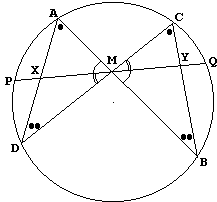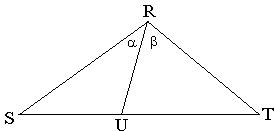 |
Cut The Knot!by Alex Bogomolny |
The Lepidoptera of the Circles
May 2003
![]()
|
The insect order Lepidoptera, with as many as 100,000 species, is second only to the Coleoptera, the beetles. In addition to the familiar butterflies and moths the order includes the skippers, a worldwide group intermediate between butterflies and moths. ... With the exception of a few moths, all adult Lepidoptera have two pairs of wings. Encyclopædia Britannica |
The so called Butterfly Problem has a long history that, according to L. Bankoff, dates back to an 1815 issue of the Gentleman's Diary, an obviously British publication. With forty seven references, Bankoff's article remains the most complete account of the problem up to date. (A few newer references could be found on the Web.) Bankoff ascribes the difficulty in tracing the history of the problem to the fact that the Butterfly appellation made its first appearance as the title of the solutions published in the American Mathematical Monthly in February 1944. Since Howard Eves was at the time the editor of the Elementary Problem Department of the Monthly it is reasonable to assume that he was the first to notice the semblance of the shape in the middle of the problem's diagram to the ubiquitous insect.
Eves' own account has appeared in print twice: as the selection 245° in his Mathematical Circles Revisited and in an interview with D. J. Albers. Eves' language, however, might suggest that this particular butterfly species had been identified earlier. Intrigued by "an elusive and tantalizing little problem in elementary geometry known as the 'butterfly problem'", he ran it as Problem E 571 in the May 1943 issue of the Monthly.
A classic formulation refers to the midpoint of a chord in a circle:
 | |
| (A) | In a circle, M is the midpoint of chord PQ. Chords AB and CD pass through the point M. AD cuts PQ at X, and BC cuts it at Y. Prove that |
A generalization does not mention the point M explicitly, nor that it belongs to a chord:
| (B) | Given a complete quadrangle inscribed in a circle, if any line cuts two opposite sides at equal distances from the center of the circle, it cuts the other pair of opposite sides at equal distances from the center. |
The latter formulation admits lines PQ located away from the circle, the circumstance that may lead an attentive nature observer to discovering additional Lepidoptera families.
Indeed, over the time sightings were reported of various Lepidoptera. The existence of the lopsided butterfly is now a well established fact largely thanks to the efforts of A. Candy (1896). On the other hand, the Three-Winged Butterfly, as appeared in the problem section of the March 1984 issue of Mathematics Magazine, was probably a misnomer. As a matter of fact, the middle bulge in the diagram was very likely just an antennaless head rather than an unmatched wing. In any event, it played no significant role in the problem formulation and could have been done away with. The problem itself was only a particular case of (B). The report, nonetheless, has proved its worth. Among the submitted solutions there were nice generalizations by H. Eves and Jan van de Craats in which the circle, the two pairs of lines AB, CD and AD, BC had been replaced by three arbitrary conics. The new kind of Lepidopteran manifestly deserves the designation of full-curved.
A completely different kind of butterflies was discovered in 1997 by Qiu FaWen, a Chinese mathematics and physics teacher, and his students with the aid of Geometer's Sketchpad. In a recent letter Qiu FaWen pointed me to a web page where he established the existence of a 4-wing butterfly -- a proper Lepidopteran. A paraphrase of his result is now available in English. Due to the exact (4) number of wings expected from a regular butterfly, I feel it appropriate to call Qiu FaWen's result A Better Butterfly Theorem. The letter was followed by another communication -- a Geometer's Sketchpad file -- in which the existence of 2N-wing butterflies has been demonstrated experimentally. The natural habitat of the species is a collection of N circles, not necessarily concentric but having collinear centers. The configuration includes a couple of intersecting lines (spikes) with the point of intersection (nexus) in the interior of all the circles and lying on the line of the centers (spine). A third (classifier) line passes through the nexus perpendicular to the spine. Expeditiously, let's call such a configuration the (2N-wing) butterfly cradle.
The spikes are crossed by the circles in N points on each side of the nexus. 2N-wing butterflies emerge when points on one spike are joined to the points on the other in a 1-1 correspondence. (It must be mentioned that Qiu FaWen has observed even more esoteric varieties, more of the (B) kind.)
Below I am going to prove a general statement.
2N-Wing Butterfly Theorem
Observe a 2N-wing butterfly cradle. Let M denote the nexus. Assume the spikes are crossed by the circles in points AN, ..., A1, (M), B1, ..., BN and CN, ..., C1, (M), D1, ..., DN, respectively. Let p be any permutation of the index set
|
Note that for N = 1 the theorem reduces to (A). The proof depends on two lemmas.
Lemma 1

Let in ΔRST, RU be a cevian through vertex R. Introduce angles a = ∠SRU and b = ∠URT. Then
|
The proof is a two-liner that follows from the identity
Lemma 2 is a curious result in its own right.
Lemma 2

|
Assume three rays C, B, and Y emanate from point M with Y between C and B. Assume also that, for |
The proof builds on Lemma 1 which is applied to each of the triangles MCiBp(i):
| (3) | sin(b + g)/MYi = sin(g)/MBp(i) + sin(b)/MCi, |
g and b are the angles CMY and YMB, respectively. Add up all the identities (3). After rearranging the terms, we'll get
| (4) | sin(b + g)(1/MY1 + ... + 1/MYN) = sin(g)(1/MB1 + ... + 1/MBN) + sin(b)(1/MC1 + ... + 1/MCN), |
| in which the right hand side does not depend on the permutation p. The same therefore is true for the left hand side. |
Proof of Theorem
The proof easily follows from Lemma 2 by pidgin, or is it pigeon, induction (if a statement holds for
1/MS1 + ... + 1/MSN = 1/MT1 + ... + 1/MTN.
But due to Lemma 2,
|
1/MS1 + ... + 1/MSN = 1/MX1 + ... + 1/MXN, while 1/MT1 + ... + 1/MTN = 1/MY1 + ... + 1/MYN, |
| and the result follows. |
Remark 1
The theorem raises further questions. Each permutation can be represented as a product of irreducible cycles. It must be obvious that every such cycle is responsible for forming a unique butterfly. If the permutation is cyclic, the theorem yields a lone insect. However, in general, the N pairs of wings are split between a number of butterflies, one per an irreducible cycle that compose the permutation. This is an open question whether the butterflies are just stuck on top of each other and could be in principle separated, or whether their wings are so entangled that no separation is possible.
L. Bankoff was amazed with a fantastic variety of solutions to the Butterfly problem -- "some by Desargues' theorem on involution, some by the use of cross ratios, others stemming from Menelaus, analytic geometry, trigonometry, advanced Euclidean geometry, and various other modalities ..." Might the braids theory hold the answer to the problem of separation of the entangled butterflies.
Remark 2
In a personal message Douglas Rogers questioned the veracity of the opening Howard Eves story:
... I really wanted to point out that there seems to be something a little strange about Howard Eves' story about the ``Butterfly Theorem''. Not only was the poser of the problem in The American Mathematical Monthly in May, 1943 a Sol Mitchell, of the University of Toronto, the editor of the the Elementary Problems Section was given as H.S.M. Coxeter up until the issue for August/September, 1945, when Howard Eves' name appears in its place. However, Eves was listed among those who also sent in a solution but whose solutions were not reproduced.
Perhaps there is somewhat more to this story than Eves lets on?
References
- D. J. Albers, Howard Eves -- The High Elf, in In Eves' Circles, edited by J. M. Anthony, MAA, 1994
- L. Bankoff, The Metamorphosis of the Butterfly Problem, Mathematics Magazine, v 60, issue 4 (Oct., 1987), 195-210
- H. Eves, Mathematical Circles Revisited, MAA, 2003
![]()
Desargues' Theorem
- Desargues' Theorem
- 2N-Wing Butterfly Problem
- Cevian Triangle
- Do You Speak Mathematics?
- Desargues in the Bride's Chair (with Pythagoras)
- Menelaus From Ceva
- Monge from Desargues
- Monge via Desargues
- Nobbs' Points, Gergonne Line
- Soddy Circles and David Eppstein's Centers
- Pascal Lines: Steiner and Kirkman Theorems II
- Pole and Polar with Respect to a Triangle
- Desargues' Hexagon
- The Lepidoptera of the Circles
![]()
Butterfly Theorem and Variants
- Butterfly theorem
- 2N-Wing Butterfly Theorem
- Better Butterfly Theorem
- Butterflies in Ellipse
- Butterflies in Hyperbola
- Butterflies in Quadrilaterals and Elsewhere
- Pinning Butterfly on Radical Axes
- Shearing Butterflies in Quadrilaterals
- The Plain Butterfly Theorem
- Two Butterflies Theorem
- Two Butterflies Theorem II
- Two Butterflies Theorem III
- Algebraic proof of the theorem of butterflies in quadrilaterals
- William Wallace's Proof of the Butterfly Theorem
- Butterfly theorem, a Projective Proof
- Areal Butterflies
- Butterflies in Similar Co-axial Conics
- Butterfly Trigonometry
- Butterfly in Kite
- Butterfly with Menelaus
- William Wallace's 1803 Statement of the Butterfly Theorem
- Butterfly in Inscriptible Quadrilateral
- Camouflaged Butterfly
- General Butterfly in Pictures
- Butterfly via Ceva
- Butterfly via the Scale Factor of the Wings
- Butterfly by Midline
- Stathis Koutras' Butterfly
- The Lepidoptera of the Circles
- The Lepidoptera of the Quadrilateral
- The Lepidoptera of the Quadrilateral II
- The Lepidoptera of the Triangle
- Two Butterflies Theorem as a Porism of Cyclic Quadrilaterals
- Two Butterfly Theorems by Sidney Kung
- Butterfly in Complex Numbers
|Contact| |Front page| |Contents|
Copyright © 1996-2018 Alexander Bogomolny
73594708
